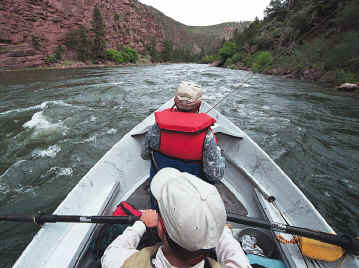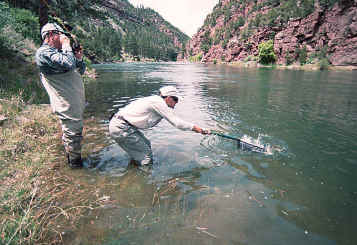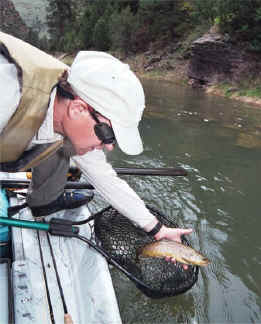
Garf in front as we run the Green with Jim Hickey.
I brace with my feet as the boat bucks through the aptly named
Roller Coaster Rapid. My fishing companion, Larry Garfinkel, is
on his first pontoon boat ride. Garf survived an LAPD career with three
gunfights and a ninety-mile-an-hour motorcycle crash, but today he says,
“I think we’re going to die.”
Running the rapids on Utah’s Green River in a nine-foot pontoon
boat is pretty easy at the 1,000 cubic feet per second normal flow. But
the day we’ve picked coincides with the spring river flushing and the
flows have been quadrupled to over 4,400 cubic feet per second. The
generators at Flaming Gorge Dam are cranking out the watts. Good news
for California’s power grid, but bad news for novice river runners.
The Green River below Flaming Gorge is a premier fly-fishing
destination, with the added spice of whitewater and we’re out to
experience it all. Normally you can avoid the big surging whitewater,
but today there are nothing but big head-high waves at the bottom of the
run.
We’re wet from flying water but don’t die and pull to shore to
catch our breath and look for fish. Normally the Green is vodka clear,
and you can see trout hanging many feet under the surface. That’s
tougher today as the higher flows make the water turbid and bits of bark
and leaves float in the back eddies where trout feed. But Larry spots
some rising heads and we beach the boats and cast to the fish.
We’re using a Mutt and Jeff combo of a large foam fly with garish
orange rubber legs that’s supposed to look like the cicadas that make
their appearance this time of year, with a tiny white cul-de-canard
midge fly trailing behind it. Cul-de-canard is French for duck’s rear
end, and that’s where “CDC” feathers come from. They have natural
preen oils that help them float and makes them very effective flies. I
watch as a trout rises through the water and confidently takes Larry’s
cicada.
Pretty soon we’re both connecting to fish, a sampling of the
healthy rainbow, wild brown, and cutthroat trout that inhabit the Green.
They’re big fish. According to Utah’s Division of Wildlife
Resources, the average size of fish in the Green is 15" to
17". The largest trout caught in the Green River was a 29-pound
brown caught in December of 1996. Previous records include a 23-pound
rainbow caught in 1985, and an 18-pound brown caught in 1993.
That evening we talk to the guy who caught the 18-pounder and
literally wrote the book on the Green River: Denny Breer. He’s opened
a new Orvis store at Dutch John and runs the largest guide service on
the river, with as many as twelve full time guides during the April to
October high season.
His book, Utah’s Green River, a Fly Fisher’s Guide to the
Flaming Gorge Tailwater, is packed with information about fishing
the Green: what bugs appear when, strategies for fishing from a drift
boat, and even a section about the politics of water management at the
Green. We’re going with one of his guides in a drift boat, the best
way to fish this river, especially if you’re new to it.
The next day we meet our guide for the day, Jim Hickey, an eight-year
veteran of guiding in Wyoming, Utah, and South America. The river offers
26 miles of fishing below the Flaming Gorge Dam in northeastern Utah.
Flowing through a red rock canyon, the river is divided into three
sections: A, B, and C for access purposes. The first, A section, holds
the most trout and is most heavily fished both by wading and drift boat.
The middle, B section, holds fewer fish, but is less pressured, as is
the C section. The river is popular with rafters and can be very busy
during the summer.


Jim Hickey lands fish for Garf.
A short ride to the put in spot below the Flaming Gorge Dam and we
get on board. “The river’s really cranking today, “ he says. But
he’s optimistic that we’ll have a decent day of fishing despite the
flows. We’re going to fish the A section of the river between the dam
and Little Hole.

This dog won't fish.
Denny Breer has suggested that I talk to Steve Brayton, a biologist
with the Utah Division of Wildlife Resources (DWR) whose unit manages
the fishery. Brayton tells me that the purpose of raising the flows is
to mimic mother nature’s springtime snow melt runoff to aid the “T
and E” or Threatened and Endangered native fish that live in the
Green: the tiny Colorado River Pike Minnow, Razorback Suckers, and Boney
Tail Chubb.
While the primary purpose of Flaming Gorge Dam is to create water
storage and generate electricity, the rate at which the dam releases
water is decided after input from a group representing wide variety of
interested parties: The US Fish and Wildlife Department, representing
the T and E fish, Brayton’s unit who manage the sport fishery, fishing
guides like Denny Breer, commercial rafting interests, the Utah Farm
Bureau, and even the Flaming Gorge Yacht Club who’s members boat in
the lake above the dam, and of course the power generation people.
The group thrashes out recommendations about flows. The power people
want daily fluctuation with peaks in am and pm. But the trout do best
with flat daily flows and gradual changes. Despite the differing
interests the group seems to work. Brayton points out they’re not in
litigation and manage to provide what’s needed for the T and E fish,
and then try to accommodate other interests, including California’s
power mess. He says they can try to ameliorate situations like
California’s rolling blackouts but that he can’t see sacrificing a
resource for what’s essentially a short-term man-created problem. The
endangered plants, fish and wildlife that depend on stable flows from
this river.
Back on the river we try some deep nymphing but the response is
sluggish. Same for tugging streamers through likely water, no takes. But
when we concentrate on casting dry flies to the rising fish in the huge
back eddies, bingo, we’ve got fish. The cutthroats live up to their
reputation as the dumbest fish in the river and are fairly easy to
catch.
According to Steve Brayton , the Utah DWR planted up to 15,000 Snake
River Cutts in the past, but hasn’t done so recently as they’re
concerned about getting disease free stock. Whirling disease, which has
decimated other trout fisheries in Montana and elsewhere, hasn’t show
up on the Green below Flaming Gorge yet, but it’s coming closer: it’s
been found in the Green in Wyoming above Fontenelle Reservoir about an
hour’s drive to the north.
The Utah DWR will plant 25, 000 rainbows this year and are
considering using “triploid” fish. These are hatchery-raised fish
that have been temperature shocked to produce a third set of
chromosomes, which renders them sterile. The advantage of sterile fish
is that they won’t cross breed with the cutthroats and can spend all
their energy getting bigger instead of reproducing. The rainbows can
spawn in the river, but don’t survive, as the juvenile fish under
about 13” don’t make it through the Utah winter.
This has lead to the special “slot limit” fishing regulations
here: anglers may keep two fish under 13 inches, and one above 20”.
All fish between 13 and 20 have to be released and only artificial flies
and lures are allowed. Brayton explains that the regulations reflect
that the smaller fish don’t make it through the winter, and that the
larger fish above 20 inches tend to die off due to natural causes, so
keeping a couple of smaller fish and the occasional trophy doesn’t
harm the fishery. And as studies have shown up to an 80 percent
mortality rate for fish caught on bait and released, artificials only
are the rule.
The rainbows are normally stocked in July at seven inches, and grow
an inch a month in the river’s fertile environment so they’re able
to get past the critical 13-inch size by winter. Fortunately for fly
fishers the trout are well acclimated to the river environment by the
following year and behave more like wild fish than pellet eating
stockers.
Part of what makes the Green one of the West’s best trout rivers is
the “selective withdrawal structures” that were fitted to Flaming
Gorge Dam. These allow water to be released from the dam from various
depths, which means various temperatures. In winter warmer surface water
is released, in summer colder water from the depths of the reservoir.
Brayton says he strives to maintain specific target temperatures, which
change with the volume of water. In drought years with low summer flows
warm water can be lethal to the fish, so flows are modeled on a computer
and managed to avoid problems.
All this care results in a fishery that attracts fly fishermen from
around the world and that fishes consistently throughout the year,
according to Breer. And we can attest to that. Even with the high flows
we’re able to bring at least 25 fish to the boat: a “Grand Slam”
of healthy rainbows, cutthroats, and browns. We release them all, and
enjoy a day of rushing water, osprey wheeling overhead, and having
someone else guiding us through the Rollercoaster Rapid so we don’t
die.
IF YOU GO
Getting there: “There” is Dutch John, the closest town to the
A section of the river is accessible from Rock Springs, Wyoming to the
north and Salt Lake City, Utah from the west via I-80. You might even
see deer and antelope playing! Or take Hwy. 40 east out of Salt Lake to
Flaming Gorge via Vernal, Utah, but you'll encounter some steep climbs
and many switchbacks on this route - however it is scenic. Total
distance from LA via I-80 is about 900+ miles or 16+ hours of driving. A
good break is to stop in Provo, UT and fish the eponymous river. Another
option is to fly to Salt Lake City and then rent a car.
Lodging: There are two lodges in the area: Flaming Gorge Lodge
Phone 1-435-889-3773 website fglodge.com and Red Canyon Lodge (this one
has a trout pond on the premises) Phone -435-889-3759 website
redcanyonlodge.com
Camping: There are many campgrounds in the Flaming Gorge
Recreational area for RV's and tent/car campers. The closest to Little
Hole is Dripping Springs, which is also the only campground open
year-round. Reservations are advised from Memorial Day through Labor
Day. For Recreation Reservations call: 1-877-444-6777 or visit the NRSS
website at www.reserveusa.com.
The primitive hike in or boat in campgrounds below Little Hole are
available on a first come, first serve basis through the concessionaires
at the Little Hole facility. Currently there is a $10 per night/per site
fee. You are also required to have and use a porta-pottie system when
using these sites.
Where to fish: There are Class III rapids on the Green so leave
canoes and float tubes home. If you bring a pontoon boat be sure it’s
rated for this kind of water. It is possible to rent rafts, but the
smart choice is to go with a guide who knows the river if you don't want
to wade. A well maintained trail borders the seven-mile A section. If
you walk a couple of miles you can find less pressured water. Look for
the seams between slack water and the faster currents. Be sure to look
for back eddies where fish congregate. The fish will be facing the
opposite direction than the main current, so adjust your presentation
accordingly.
The water is generally gin clear despite the "Green" name
and gives you the opportunity to watch fish inspect your flies and
presentation, and hopefully eat them...Kind of like fishing in an
aquarium. For an excellent guide to fishing the Green, read Denny
Breer's book UTAH'S GREEN RIVER-A Fly Fishers Guide to the Flaming Gorge
Tailwater Published by Frank Amato Publications.
Suggested tackle A 9 foot 5 to 6 weight rod is a good all around
choice for nymphing and dry fly fishing the Green. You might be able to
use your 4 weight on baetis or midge hatches. Most of your fishing will
be with a floating line, you can use a sink tip or sinking line for
streamers.
Guides generally can provide single and multi day float trips on
various sections of the river. Trout Creek Flies Phone 1-435-885-3355
1-800-835-4551 Dennis & Grace Breer website fishgreenriver.com
Fishing regulations: A Utah license is required if you’re over
13 years old and can be purchased online at https://secure.e-utah.org/serv/hflonline
The trout limit is three fish, two under 13" and one over 20";
all fish between 13" and 20" must be released.
User fees: The Flaming Gorge National Recreational Area has a
user fee program. Visitors will be required to pay $2/day, $5/16 days,
$20/year. Golden Age Passes, Golden Access, Golden Eagle and Parks
Service Passes (with hologram only) are accepted. This fee is per
vehicle and passes must be displayed. They can be purchased at the local
retail stores, lodges and the visitors center at the dam. If you are
visiting either Dam Spillway or Little Hole access points there is a $2
per day parking fee, but if you are only using these access points to
fish, hike, or boat the Green you don’t need to pay the use fee. Yes,
it’s confusing.
![]()